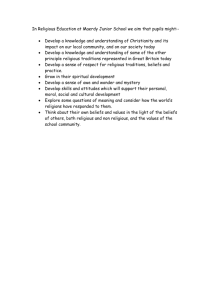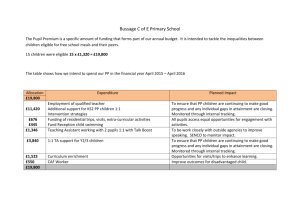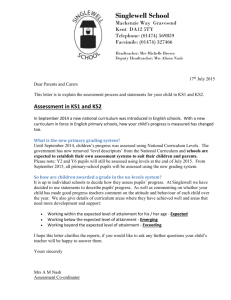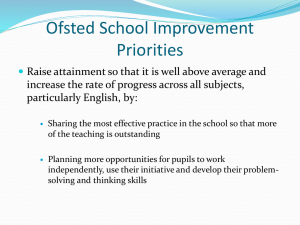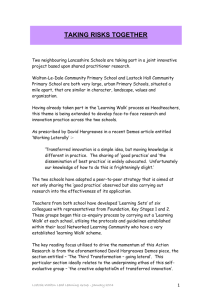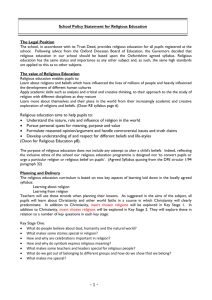2.Level Descriptors
advertisement
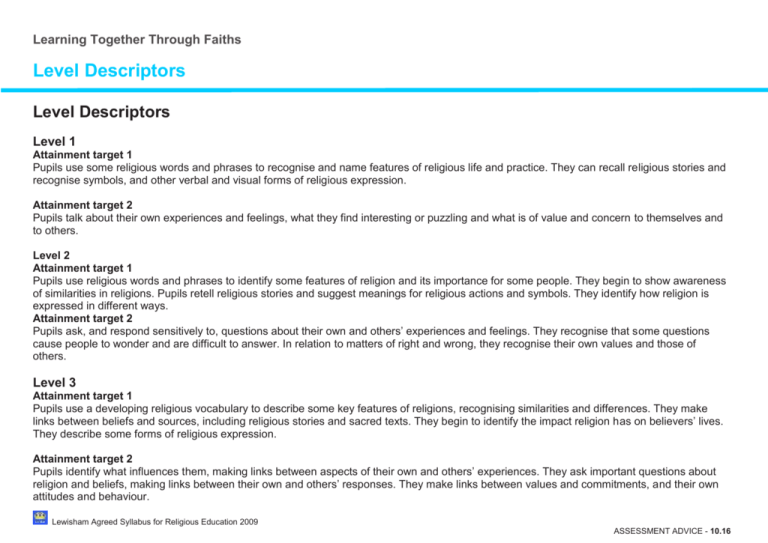
Learning Together Through Faiths Level Descriptors Level Descriptors Level 1 Attainment target 1 Pupils use some religious words and phrases to recognise and name features of religious life and practice. They can recall religious stories and recognise symbols, and other verbal and visual forms of religious expression. Attainment target 2 Pupils talk about their own experiences and feelings, what they find interesting or puzzling and what is of value and concern to themselves and to others. Level 2 Attainment target 1 Pupils use religious words and phrases to identify some features of religion and its importance for some people. They begin to show awareness of similarities in religions. Pupils retell religious stories and suggest meanings for religious actions and symbols. They identify how religion is expressed in different ways. Attainment target 2 Pupils ask, and respond sensitively to, questions about their own and others’ experiences and feelings. They recognise that some questions cause people to wonder and are difficult to answer. In relation to matters of right and wrong, they recognise their own values and those of others. Level 3 Attainment target 1 Pupils use a developing religious vocabulary to describe some key features of religions, recognising similarities and differences. They make links between beliefs and sources, including religious stories and sacred texts. They begin to identify the impact religion has on believers’ lives. They describe some forms of religious expression. Attainment target 2 Pupils identify what influences them, making links between aspects of their own and others’ experiences. They ask important questions about religion and beliefs, making links between their own and others’ responses. They make links between values and commitments, and their own attitudes and behaviour. Lewisham Agreed Syllabus for Religious Education 2009 ASSESSMENT ADVICE - 10.16 Learning Together Through Faiths Level Descriptors Level 4 Attainment target 1 Pupils use a developing religious vocabulary to describe and show understanding of sources, practices, beliefs, ideas, feelings and experiences. They make links between them, and describe some similarities and differences both within and between religions. They describe the impact of religion on people’s lives. They suggest meanings for a range of forms of religious expression. Attainment target 2 Pupils raise, and suggest answers to, questions of identity, belonging, meaning, purpose, truth, values and commitments. They apply their ideas to their own and other people’s lives. They describe what inspires and influences themselves and others. Level 5 Attainment target 1 Pupils use an increasingly wide religious vocabulary to explain the impact of beliefs on individuals and communities. They describe why people belong to religions. They understand that similarities and differences illustrate distinctive beliefs within and between religions and suggest possible reasons for this. They explain how religious sources are used to provide answers to ultimate questions and ethical issues, recognising diversity in forms of religious, spiritual and moral expression, within and between religions. Attainment target 2 Pupils ask, and suggest answers to, questions of identity, belonging, meaning, purpose and truth, values and commitments, relating them to their own and others’ lives. They explain what inspires and influences them, expressing their own and others’ views on the challenges of belonging to a religion. Lewisham Agreed Syllabus for Religious Education 2009 ASSESSMENT ADVICE - 10.17 Learning Together Through Faiths Level Descriptors Level 6 Attainment target 1 Pupils use religious and philosophical vocabulary to give informed accounts of religions and beliefs, explaining the reasons for diversity within and between them. They explain why the impact of religions and beliefs on individuals, communities and societies varies. They interpret sources and arguments, explaining the reasons that are used in different ways by different traditions to provide answers to ultimate questions and ethical issues. They interpret the significance of different forms of religious, spiritual and moral expression. Attainment target 2 Pupils use reasoning and examples to express insights into the relationship between beliefs, teachings and world issues. They express insights into their own and others’ views on questions of identity and belonging, meaning, purpose and truth. They consider the challenges of belonging to a religion in the contemporary world, focusing on values and commitments. Level 7 Attainment target 1 Pupils use a wide religious and philosophical vocabulary to show a coherent understanding of a range of religions and beliefs. They analyse issues, values and questions of meaning and truth. They account for the influence of history and culture on aspects of religious life and practice. They explain why the consequences of belonging to a faith are not the same for all people within the same religion or tradition. They use some of the principal methods by which religion, spirituality and ethics are studied, including the use of a variety of sources, evidence and forms of expression. Attainment target 2 Pupils articulate personal and critical responses to questions of meaning, purpose, truth and ethical issues. They evaluate the significance of religious and other views for understanding questions of human relationships, belonging, identity, society, values and commitments, using appropriate evidence and examples. Lewisham Agreed Syllabus for Religious Education 2009 ASSESSMENT ADVICE - 10.18 Learning Together Through Faiths Level Descriptors Level 8 Attainment target 1 Pupils use a comprehensive religious and philosophical vocabulary to analyse a range of religions and beliefs. They contextualize interpretations of religion with reference to historical, cultural, social and philosophical ideas. They critically evaluate the impact of religions and beliefs on differing communities and societies. They analyse differing interpretations of religious, spiritual and moral sources, using some of the principal methods by which religion, spirituality and ethics are studied. They interpret and evaluate varied forms of religious, spiritual and moral expression. Attainment target 2 Pupils coherently analyse a wide range of viewpoints on questions of identity, belonging, meaning, purpose, truth, values and commitments. They synthesise a range of evidence, arguments, reflections and examples, fully justifying their own views and ideas and providing a detailed evaluation of the perspectives of others. Exceptional Performance Attainment target 1 Pupils use a complex religious, moral and philosophical vocabulary to provide a consistent and detailed analysis of religions and beliefs. They evaluate in depth the importance of religious diversity in a pluralistic society. They clearly recognise the extent to which the impact of religion and beliefs on different communities and societies has changed over time. They provide a detailed analysis of how religious, spiritual and moral sources are interpreted in different ways, evaluating the principal methods by which religion and spirituality are studied. They synthesise effectively their accounts of the varied forms of religious, spiritual and moral expression. Attainment target 2 Pupils analyse in depth a wide range of perspectives on questions of identity and belonging, meaning, purpose and truth, and values and commitments. They give independent, well-informed and highly reasoned insights into their own and others’ perspectives on religious and spiritual issues, providing well-substantiated and balanced conclusions. Lewisham Agreed Syllabus for Religious Education 2009 ASSESSMENT ADVICE - 10.19
